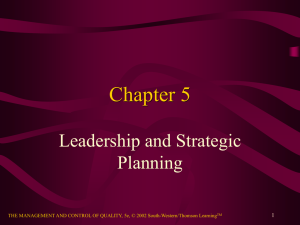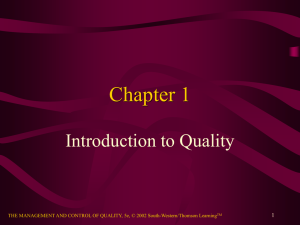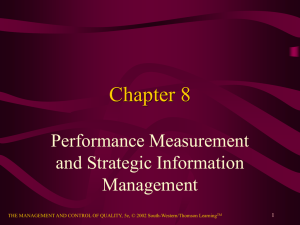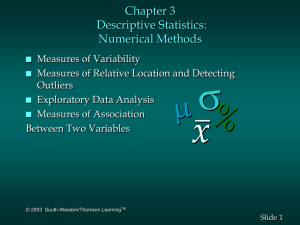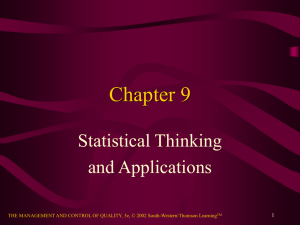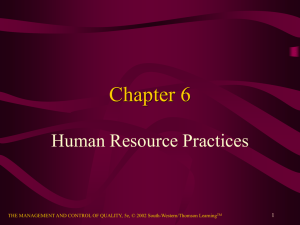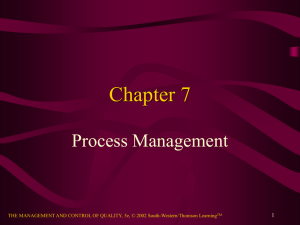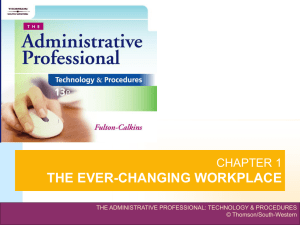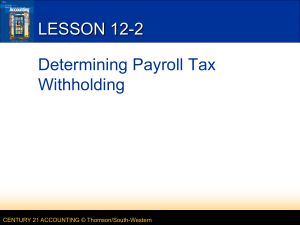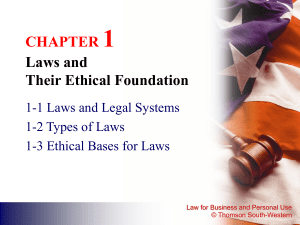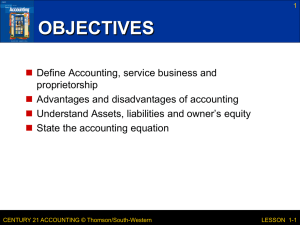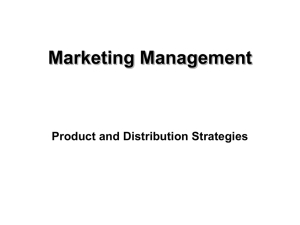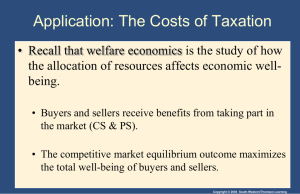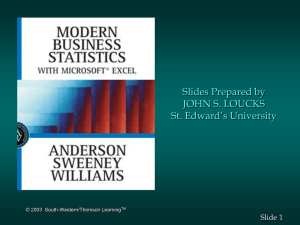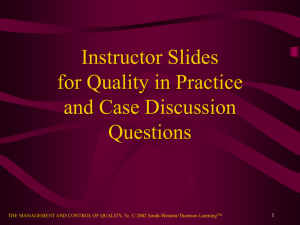Chapter 1
advertisement
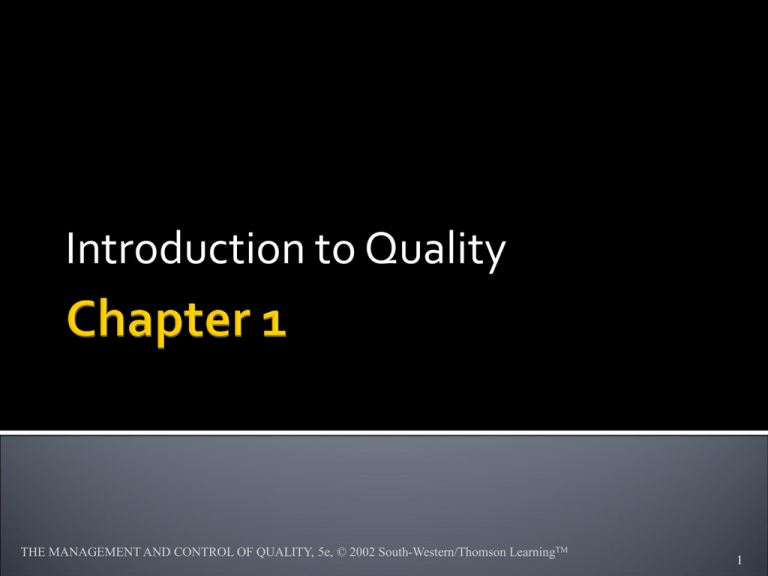
Introduction to Quality THE MANAGEMENT AND CONTROL OF QUALITY, 5e, © 2002 South-Western/Thomson LearningTM 1 “The first job we have is to turn out quality merchandise that consumers will buy and keep on buying. If we produce it efficiently and economically, we will earn a profit, in which you will share.” - William Cooper Procter THE MANAGEMENT AND CONTROL OF QUALITY, 5e, © 2002 South-Western/Thomson LearningTM 2 ...is any action directed toward providing customers with goods and services of appropriate quality. THE MANAGEMENT AND CONTROL OF QUALITY, 5e, © 2002 South-Western/Thomson LearningTM 3 Skilled craftsmanship during Middle Ages Industrial Revolution: rise of inspection and separate quality departments Statistical methods at Bell System Quality control during World War II Quality management in Japan THE MANAGEMENT AND CONTROL OF QUALITY, 5e, © 2002 South-Western/Thomson LearningTM 4 Quality awareness in U.S. manufacturing industry during 1980s: “Total Quality Management” Malcolm Baldrige National Quality Award (1987) Quality in service industries, government, health care, and education Current and future challenge: keep progress in quality management alive THE MANAGEMENT AND CONTROL OF QUALITY, 5e, © 2002 South-Western/Thomson LearningTM 5 Parterning Learning systems Adaptability and speed of change Environmental sustainability Globalization Knowledge focus Customization and differentiation Shifting demographics THE MANAGEMENT AND CONTROL OF QUALITY, 5e, © 2002 South-Western/Thomson LearningTM 6 Transcendent definition: excellence Product-based definition: quantities of product attributes User-based definition: fitness for intended use Value-based definition: quality vs. price Manufacturing-based definition: conformance to specifications THE MANAGEMENT AND CONTROL OF QUALITY, 5e, © 2002 South-Western/Thomson LearningTM 7 transcendent & product-based user-based needs Marketing Customer products and services value-based Design manufacturingbased Manufacturing Distribution Information flow Product flow THE MANAGEMENT AND CONTROL OF QUALITY, 5e, © 2002 South-Western/Thomson LearningTM 8 “Meeting or exceeding customer expectations” Customers can be... Consumers External customers Internal customers THE MANAGEMENT AND CONTROL OF QUALITY, 5e, © 2002 South-Western/Thomson LearningTM 9 People-focused management system Focus on increasing customer satisfaction and reducing costs A systems approach that integrates organizational functions and the entire supply chain Stresses learning and adaptation to change Based on the scientific method THE MANAGEMENT AND CONTROL OF QUALITY, 5e, © 2002 South-Western/Thomson LearningTM 10 Customer and stakeholder focus Participation and teamwork Process focus and continuous improvement ...supported by an integrated organizational infrastructure, a set of management practices, and a set of tools and techniques THE MANAGEMENT AND CONTROL OF QUALITY, 5e, © 2002 South-Western/Thomson LearningTM 11 Customer is principal judge of quality Organizations must first understand customers’ needs and expectations in order to meet and exceed them Organizations must build relationships with customers Customers include employees and society at large THE MANAGEMENT AND CONTROL OF QUALITY, 5e, © 2002 South-Western/Thomson LearningTM 12 Employees know their jobs best and therefore, how to improve them Management must develop the systems and procedures that foster participation and teamwork Empowerment better serves customers, and creates trust and motivation Teamwork and partnerships must exist both horizontally and vertically THE MANAGEMENT AND CONTROL OF QUALITY, 5e, © 2002 South-Western/Thomson LearningTM 13 A process is a sequence of activities that is intended to achieve some result THE MANAGEMENT AND CONTROL OF QUALITY, 5e, © 2002 South-Western/Thomson LearningTM 14 Enhancing value through new products and services Reducing errors, defects, waste, and costs Increasing productivity and effectiveness Improving responsiveness and cycle time performance THE MANAGEMENT AND CONTROL OF QUALITY, 5e, © 2002 South-Western/Thomson LearningTM 15 The foundation for improvement … Understanding why changes are successful through feedback between practices and results, which leads to new goals and approaches Learning cycle: Planning Execution of plans Assessment of progress Revision of plans based on assessment findings THE MANAGEMENT AND CONTROL OF QUALITY, 5e, © 2002 South-Western/Thomson LearningTM 16 Infrastructure Leadership Practices Tools Strategic Planning HRM Performance appraisal Process mgt. Data and information management Training Trend chart THE MANAGEMENT AND CONTROL OF QUALITY, 5e, © 2002 South-Western/Thomson LearningTM 17 Customer relationship management Leadership and strategic planning Human resources management Process management Data and information management THE MANAGEMENT AND CONTROL OF QUALITY, 5e, © 2002 South-Western/Thomson LearningTM 18 Is driven by customer wants and needs Makes significant contribution to business success Matches organization’s unique resources with opportunities Is durable and lasting Provides basis for further improvement Provides direction and motivation Quality supports each of these characteristics THE MANAGEMENT AND CONTROL OF QUALITY, 5e, © 2002 South-Western/Thomson LearningTM 19 General Accounting Office study of Baldrige Award applicants Baldrige stock study (see www.quality.nist.gov) Hendricks and Singhal study of quality award winners Performance results of Baldrige Award winners THE MANAGEMENT AND CONTROL OF QUALITY, 5e, © 2002 South-Western/Thomson LearningTM 20 Organizational level: meeting external customer requirements Process level: linking external and internal customer requirements Performer/job level: meeting internal customer requirements THE MANAGEMENT AND CONTROL OF QUALITY, 5e, © 2002 South-Western/Thomson LearningTM 21 Personal initiative has a positive impact on business success Quality begins with personal attitudes Quality-focused individuals often exceed customer expectations Attitudes can be changed through awareness and effort (e.g., personal quality checklists) THE MANAGEMENT AND CONTROL OF QUALITY, 5e, © 2002 South-Western/Thomson LearningTM 22
